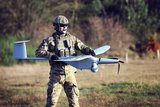Israel uses new F-35 stealth fighters in combat
The Israeli military has used its newly acquired F-35 stealth fighters in combat, making it the world's first to do so, an Israeli Air Force (IAF) Commander said on 22 May.
Using the plane's Hebrew name, Major General Amikam Norkin said at a conference in central Israel: ‘The Adir aircraft are already operational and flying combat missions. In fact, we have performed the first operational F-35 strike in the world.’
Norkin said in remarks quoted by the air force's website: ‘We attacked twice in the Middle East using the F-35 – we are the first in the world to do so.’
Israel has carried out a number of strikes in Syria against what it describes as Iranian targets as well as on what it says are advanced arms deliveries to Hezbollah.
The country has agreed to buy 50 of the American high-tech stealth bombers, which will help it maintain military superiority in the turbulent Middle East, particularly regarding anti-aircraft missile systems in Syria.
In December 2017, the IAF announced that the nine F-35 jets in its possession at the time were operational.
Norkin was speaking at an event marking the IAF’s 70th anniversary in Herzliya, north of Tel Aviv, attended by senior air force officials from over 20 countries, the military said.
Israel has pledged to prevent its main enemy Iran from entrenching itself militarily in neighbouring Syria, where Tehran is backing President Bashar al-Assad's regime.
Earlier in May 2018, Israel launched a large-scale attack on what it said were Iranian targets in Syria, raising fears of a major confrontation.
Those strikes followed a barrage of rockets that Israel said was fired toward its forces in the occupied Golan Heights by Iran from Syria.
In his comments on 22 May, Norkin also made reference to an Israeli strike on missiles Iran had allegedly transported to Syria, without providing a timeframe.
Norkin said: ‘Over the past weeks, we understood that Iran was transporting long-range missiles and rockets to Syria, among which are 'Uragan' missile launchers which we attacked, just north of Damascus.’
He then went on to describe the series of events on 9 and 10 May.
Norkin said: ‘The Iranians fired 32 rockets. We intercepted four of them and the rest fell outside Israeli territory. Afterwards, we attacked dozens of Iranian targets in Syria.’
He noted that over 100 ground-to-air missiles were fired at Israeli planes during the attack.
The strikes left at least 27 pro-regime fighters dead, including 11 Iranians, according to the Britain-based Syrian Observatory for Human Rights.
Israel has been blamed for a series of other recent strikes inside Syria that have killed Iranians, though it has not acknowledged them.
As a result, Israel had been preparing itself for weeks for possible Iranian retaliation.
More from Defence Notes
-
![Taiwan approved for purchase of $11 billion in weapons from US]()
Taiwan approved for purchase of $11 billion in weapons from US
The US State Department’s approval of a multi-billion-dollar sale of weapons to Taiwan includes tactical mission networks equipment, uncrewed aerial systems, artillery rocket systems and self-propelled howitzers as well as anti-tank guided missiles.
-
![Ireland spells out $2.3 billion shopping list in five-year defence spending plan]()
Ireland spells out $2.3 billion shopping list in five-year defence spending plan
Ireland’s multi-annual investment in capital defence spending is set to rise from €300m in 2026 to €360m in 2029–2030 with major upgrades across land, air, maritime and cyber domains.
-
![US National Security Strategy prioritises advanced military capabilities and national industry]()
US National Security Strategy prioritises advanced military capabilities and national industry
The 2025 NSS has emphasised investment in the US nuclear and air defence inventory and national industry, but it leaves multiple unanswered questions on how the White House will implement this approach.
-
![Canada set to look away from its neighbour and across the Atlantic for partners]()
Canada set to look away from its neighbour and across the Atlantic for partners
While non-EU UK struggles to join the Security Action for Europe initiative, which provides loans for defence programmes, Canada has become the first country outside Europe to get access – and did so for a nominal fee.
-
![NATO experiments with solutions to integrate networks, AI and uncrewed systems]()
NATO experiments with solutions to integrate networks, AI and uncrewed systems
During the latest edition of the NATO DiBaX, the alliance tested multiple capabilities to inform requirements for future efforts.

























